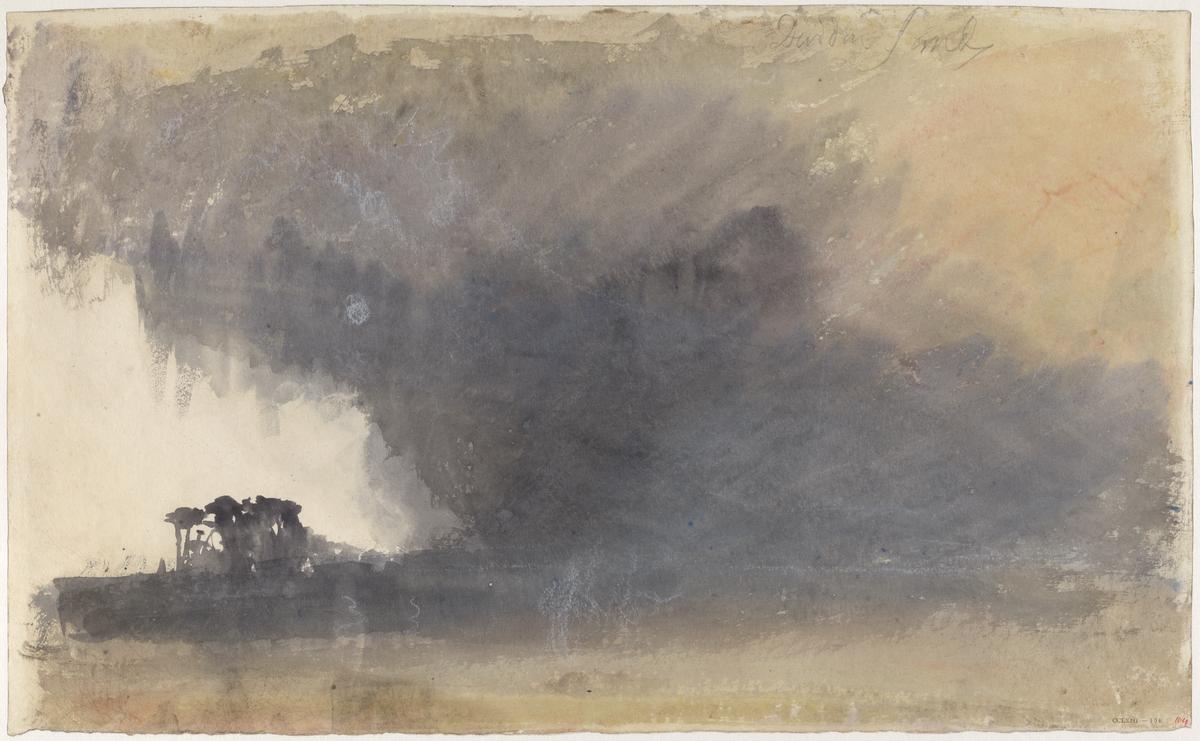Joseph Mallord William Turner Duddon Sands, Cumbria c.1825-32
Joseph Mallord William Turner,
Duddon Sands, Cumbria
c.1825-32
Joseph Mallord William Turner 1775–1851
Duddon Sands, Cumbria c.1825–32
D25226
Turner Bequest CCLXIII 104
Turner Bequest CCLXIII 104
Pencil, watercolour and chalk on white wove paper, 276 x 452 mm
Inscribed by Turner in pencil ‘Duddon Sands’ towards top right
Inscribed in red ink ‘104’ bottom right
Blind-stamped with Turner Bequest monogram towards bottom centre
Stamped in black ‘CCLXIII – 104’ bottom right
Inscribed by Turner in pencil ‘Duddon Sands’ towards top right
Inscribed in red ink ‘104’ bottom right
Blind-stamped with Turner Bequest monogram towards bottom centre
Stamped in black ‘CCLXIII – 104’ bottom right
Accepted by the nation as part of the Turner Bequest 1856
Exhibition history
1936
Watercolours from the Turner Bequest [Loan Series G], Empire Loan Collections Society, National Gallery, Cape Town, May 1936–June 1937 (no catalogue but frame number 12, as ‘Duddon Sands’).
1938
Four Screens, British Museum, London, March–September 1938 (no catalogue but frame number 14, as ‘Duddon Sands’).
1971
Watercolours by J.M.W. Turner (1778 [sic] –1851): Lent by the Trustees of the British Museum, Abbot Hall Art Gallery, Kendal, January–March 1971 (17, as ‘Duddon Sands’).
1972
J.M.W. Turner: Gemälde Aquarelle, Nationalgalerie Staatliche Museen Preußischer Kulturbesitz, Berlin, September–November 1972 (64, as ‘Duddon Sands’, 1820/30).
1973
Turner {1775 / 1851}: desenhos, aguarelas e óleos / Drawings, Watercolours and Oil Paintings, Fundação Calouste Gulbenkian, Lisbon, June–July 1973 (28, reproduced, as ‘Duddon Sands’, 1820/30).
1975
Turner in the British Museum: Drawings and Watercolours, Department of Prints and Drawings, British Museum, London, May 1975–February 1976 (167, reproduced, as ‘Duddon Sands’, ?c.1830).
1995
Sketching the Sky: Watercolours from the Turner Bequest, Tate Gallery, London, September 1995–February 1996 (no catalogue number, as ‘Duddon Sands’, c.1825–32).
2007
Hockney on Turner Watercolours, Tate Britain, London, June 2007–February 2008 (no number, reproduced in colour, as ‘Duddon Sands’, c.1825–32).
2011
William Turner. Maler der Elemente / Turner and the Elements, Bucerius Kunst Forum, Hamburg, June–September 2011, Muzeum Narodowe, Krakow, October–January 2012, Turner Contemporary, Margate, January–May 2012 (45, reproduced in colour, as ‘Duddon Sands’, c.1825–32).
References
1909
A.J. Finberg, A Complete Inventory of the Drawings of the Turner Bequest, London 1909, vol.II, p.822, CCLXIII 104, as ‘“DUDDON SANDS”’. c.1820–30.
1975
Gerald Wilkinson, Turner’s Colour Sketches 1820–34, London 1975, p.115, reproduced in colour.
1975
Andrew Wilton, Turner in the British Museum: Drawings and Watercolours, exhibition catalogue, Department of Prints and Drawings, British Museum, London 1975, p.106 no.167, reproduced, as ‘Duddon Sands’. ?c.1830.
1981
Giichi Nakamura, ‘Turner: A Japanese Appreciation’, Turner Society News, no.22, Summer 1981, p.4, reproduced.
1997
Eric Shanes, Turner’s Watercolour Explorations 1810–1842, exhibition catalogue, Tate Gallery, London 1997, p.96 Appendix I under ‘England and Wales Series’, as ‘Sketch for a view of “DUDDON SANDS” (i.e. Duddon Sands, near Barrow-in-Furness, Cumbria’), p.102 under ‘Sky Sketches’, p.105 Appendix II, as ‘Sketch: Duddon Sands, near Barrow-in-Furness, Cumbria’.
2007
Simon Grant (ed.) and David Blayney Brown, Hockney on Turner Watercolours, exhibition catalogue, Tate Britain, London 2007, pp.46–7, reproduced in colour, as ‘Duddon Sands’. c.1825–32.
Forming the estuary of the River Duddon, Duddon Sands lie between Broughton- and Barrow-in-Furness, at the south-west corner of the Lake District. Turner had passed through Ulverston, a few miles to the west, in 1816,1 but there are no identified Duddon views from that tour; he had been in the area in 1809, and there are views of Millom Castle, above the western bank of the estuary, in the Petworth and Sandycombe and Yorkshire sketchbooks (Tate D07534, D07535, D08975, D08976, D08978, D08998 D09001; Turner Bequest CIX 22, 23, CXXVII 9, 9a, 11, 23a, 25a).
The latter sketchbook also includes what may be a view of the Lake District mountains from Duddon Sands (Tate D08969; Turner Bequest CXXVII 5), although the present view, with its silhouetted trees and vast mass of storm clouds can hardly be described as conventionally topographical. As part of Giichi Nakamura’s article discussing the appreciation of Turner in Japan, the present work was reproduced beside a gestural, free-form Landscape in the Style of Yu-Chein, dated to the second half of the fifteenth century.2
Without suggesting a date, Eric Shanes has proposed this work as an undeveloped subject for Turner’s Picturesque Views in England and Wales,3 which he worked on between about 1825 and 1838; the range date of circa 1825–32 adopted for recent exhibitions has been retained here. See also the introductions to the present subsection of identified but unrealised subjects and the overall England and Wales ‘colour beginnings’ grouping to which this work has been assigned.
Technical notes:
Turner’s fingerprints are evident at the ragged edge of the clouds above the silhouetted trees on the left. Unusually, white chalk has been applied over the washes, apparently to suggest figures at the bottom centre, and as an irregular disk above the trees, perhaps indicating the sun through the watery cloud.1
Turner’s fingerprints are evident at the ragged edge of the clouds above the silhouetted trees on the left. Unusually, white chalk has been applied over the washes, apparently to suggest figures at the bottom centre, and as an irregular disk above the trees, perhaps indicating the sun through the watery cloud.1
Verso:
Blank, save for inscriptions: by ?Turner in pencil ‘33’ towards centre right, upside down; stamped in black with Turner Bequest monogram above ‘CCLXIII – 104’ bottom right; and in pencil ‘CCLXIII 104 | D25226’ bottom right.
Blank, save for inscriptions: by ?Turner in pencil ‘33’ towards centre right, upside down; stamped in black with Turner Bequest monogram above ‘CCLXIII – 104’ bottom right; and in pencil ‘CCLXIII 104 | D25226’ bottom right.
Matthew Imms
March 2013
How to cite
Matthew Imms, ‘Duddon Sands, Cumbria c.1825–32 by Joseph Mallord William Turner’, catalogue entry, March 2013, in David Blayney Brown (ed.), J.M.W. Turner: Sketchbooks, Drawings and Watercolours, Tate Research Publication, December 2013, https://www

